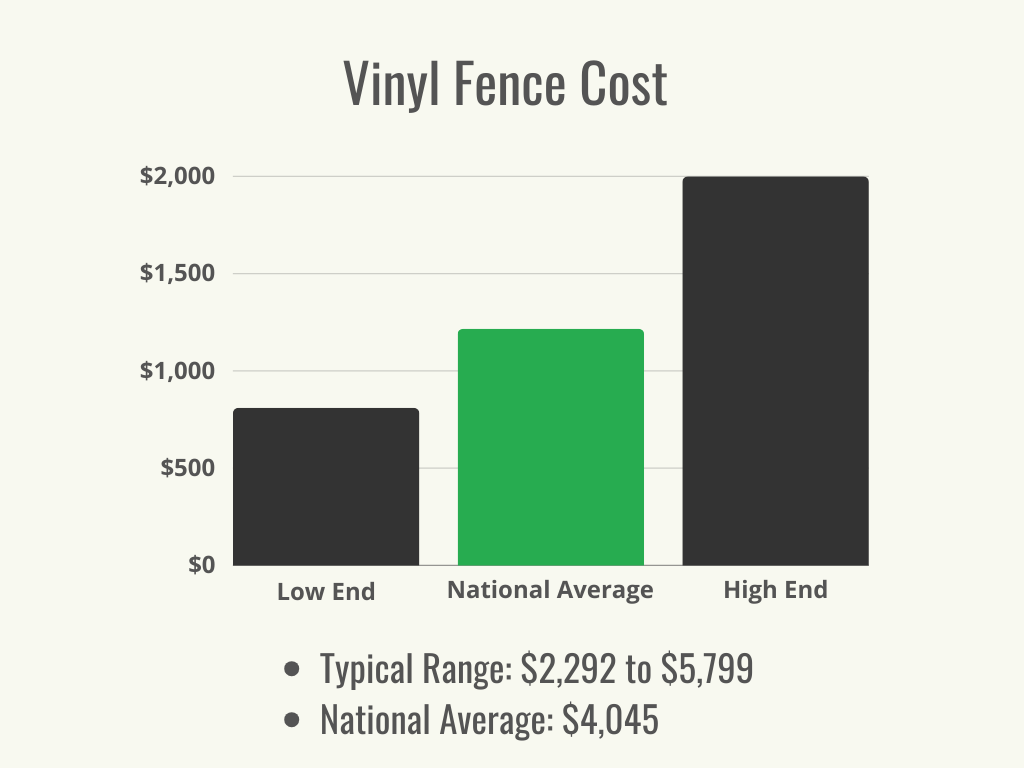

We may earn revenue from the products available on this page and participate in affiliate programs. Learn More ›
Highlights
- The typical range for vinyl fence installation costs is $2,292 to $5,799, with a national average of $4,045.
- The most significant cost factors associated with installing a vinyl fence include fence length and height, type, color, number and type of posts, gates, and labor.
- Vinyl fences have many benefits, including easy maintenance, strength and durability, long-term cost savings, ease of installation, aesthetic appeal, and pest resistance.
- Installing vinyl fences requires a high level of precision and skill that the average homeowner will struggle to achieve. For the best and most efficient results, it’s important to have a professional take care of this job.
Building a fence is a common homeowner task to check off, particularly with a new construction home. But even homes that have been around for a while might need a fence replaced or installed. Fences come in a few different styles and price ranges, from classic white vinyl fences to extensive faux granite privacy fences. Vinyl fences tend to be one of the best-looking and lowest-cost fences on the market.
So how much does vinyl fencing cost? According to Angi and HomeAdvisor, the cost of a vinyl fence ranges from $2,292 to $5,799, though the national average is $4,045. This includes the cost of labor, materials, and any permits needed to build a plastic fence. However, there are a lot of other unique circumstances that can make up vinyl fence costs; this guide will help homeowners discover what to expect while budgeting for this project.
How to Calculate Vinyl Fence Cost
To calculate the basic price of vinyl fence installation, homeowners will first need to determine how many linear feet of fencing are required and the average vinyl fencing cost in the area. Searching online for “vinyl fence installation near me” can help homeowners locate a local fencing company that can provide an accurate quote. Below is a quick way to roughly estimate the cost without a vinyl fencing cost calculator.
- Measure how many feet of fencing need to be installed.
- Multiply the total linear feet by the cost of materials and labor (usually $15 to $40 per linear foot).
- Add the cost of a gate, which ranges from $300 to $1,500, and the cost of installing it at the typical rate of $35 to $50 per hour.
For example, 100 feet of vinyl fencing could cost $1,500 to $6,000. A complete privacy fence would land at the higher end of the cost range, while a picket fence would cost closer to the lower end.
Factors in Calculating Vinyl Fence Cost
It might seem like calculating the cost to install a vinyl fence is a simple process. Still, a fence installer must consider several factors in order to calculate an accurate price. Vinyl fence costs are determined by the design, height, number of posts and gates, slope of the property, and cost of labor and permits. Each of these factors is explored in detail below.
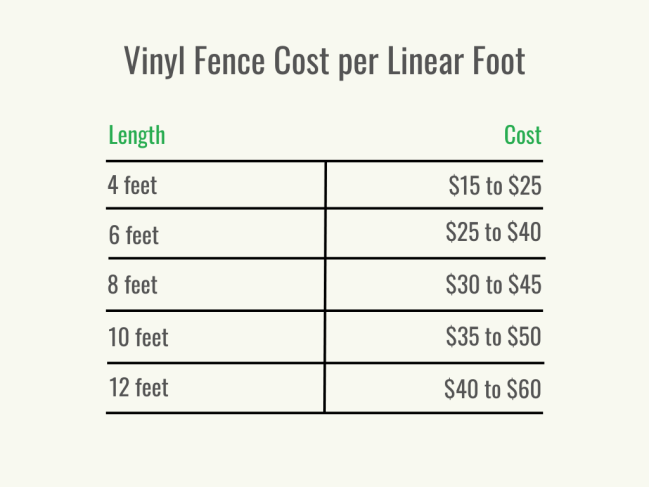
Fence Length
The longer the fence, the higher the cost, so homeowners with a large yard to enclose will end up paying more. The vinyl fence cost per foot is $15 to $40. Not only will a longer fence require more materials, but it will take longer to install, which can drive up labor costs. Any extra features like gates can increase labor costs by $35 to $50 per hour.
| Fence Length | Average Cost Per Linear Foot (Materials and Labor) |
| 4 feet | $15 to $25 |
| 6 feet | $25 to $40 |
| 8 feet | $30 to $45 |
| 10 feet | $35 to $50 |
| 12 feet | $40 to $60 |
Fence Height
The height of a PVC fence is a significant factor in the overall cost. Shorter fences are usually 4 feet high and cost $15 to $25 per linear foot. A 6-foot fence averages $25 to $40 per linear foot, while an 8-foot fence costs between $30 and $45 per linear foot. These price ranges will also vary based on the type of fence. Below are the typical costs for fences of differing heights.
| Fence Height | Average Cost per Linear Foot (Materials and Labor) |
| 4 feet | $15 to $25 |
| 6 feet | $25 to $40 |
| 8 feet | $30 to $45 |
| 10 feet | $35 to $50 |
| 12 feet | $40 to $60 |
Fence Type
While some homeowners opt for a complete privacy fence, others might choose to do a lower picket fence, a three-rail fence, or a mix around their property. Privacy fences cost the most since they are the tallest and have the most plastic fence panels. The average cost is $15 to $40 per linear foot. There is also the choice between installing a traditional straight fence or having a design built into the panels, such as horizontal, lattice, or crisscross.
A three-rail (also called split-rail, ranch, or horse) fence costs on average $11 to $18 per linear foot to install, and a picket fence costs $15 to $35 per linear foot to install. These costs can vary based on the location and the current demand. Also, there is more than one width of vinyl fence panel to choose from. An 8-foot panel will cost more than a 4-foot panel, but a 4-foot-panel fence will need more fence posts.
Fence Color
Most vinyl fences are white, since it’s the cheapest color available (about $20 to $25 per linear foot), and it makes a lovely aesthetic against the yard and house. The other standard color options to choose from are gray, black, and brown. These colors typically cost a little more, though—for example, a black vinyl fence costs up to $65 per linear foot. Some homeowners choose to have a vinyl fence that’s imprinted to look more like natural wood grain, and this typically costs around $30 to $55 per linear foot.
| Fence Color | Average Cost per Linear Foot (Materials Only) |
| Black | $30 to $65 |
| Gray | $25 to $45 |
| White | $20 to $25 |
| Wood grain | $30 to $55 |
Number and Height of Fence Posts
Fence posts are the most challenging part of installing a fence. It’s labor-intensive to dig a hole, fill it with concrete, and set the posts in it while keeping them level and perfectly in line for a straight fence. The more posts that are needed, the higher the cost, although homeowners won’t have much control over this. Vinyl fence panels can be made only so wide before they must have another post for stability. Each vinyl post costs about $25. Vinyl fence posts are usually capped to keep water out, but more decorative caps can be added with lights for an extra cost.
Fence Gates
Gates are another crucial part of a fence, as they allow for access to the front or back yard. A single gate costs between $300 and $1,500 for materials and labor, but if it’s highly decorative or it’s a double gate, then it could cost up to $2,500.
Labor
There’s no getting around the labor cost for fence installation, since it’s a labor-intensive process. Homeowners can expect to pay around $5 to $10 per linear foot for labor. This also works out to about $35 to $50 per hour. Still, labor actually makes up a smaller portion of the total cost of vinyl fencing, since the amount of materials needed outweighs the cost of labor.
Additional Costs and Considerations
In addition to the cost factors that apply to every fencing installation, there are often other costs for homeowners to consider when estimating vinyl fencing costs. The following situations may or may not apply to every property, but they can be helpful for homeowners to keep in mind.
Permits
Some municipalities have requirements for building fences on property lines, so homeowners will want to check with them about any necessary permits. The installer might be able to help with obtaining them too, so it’s worth it for homeowners to ask. Depending on the size of the fence and the number of permits needed, permitting could end up costing $20 to $60.
Property Line Survey
Before the fence is constructed, it’s important to get a property line survey so that the finished fence does not creep into the neighbor’s yard. A survey for a fence typically costs between $250 and $1,000.
Yard Slope
Building a fence on sloped ground takes more time, effort, and skill to ensure the fence is leveled correctly and doesn’t leave awkward gaps along the ground. If the slope is significant, the fence builder might need to have the ground leveled to properly build a fence that will last. Grading a slope could cost between $10 and $18 per cubic yard depending on how much work needs to be done. If grading is not needed, it will likely take longer to build the fence to compensate for the more challenging job, which means the total labor costs will be higher.
Old Fence Removal
Sometimes a new fence is replacing an old, worn-out fence. In that case, the old fence will need to be torn down and hauled away. The cost will depend on the type of fence and the amount of work required to dig out the old posts. Some fence installers will charge a flat fee, while others charge a rate per linear foot—often around $3 to $5 per linear foot.
Tree or Stump Removal
Sometimes there is existing landscaping in the way of the new fence. Trees, shrubs, logs, stumps, and other natural debris will need to be removed before the fence can be built. This might also be the case if the landscaping is simply too close to the fence line, making it difficult for the installer to work. Removing landscaping could range from $175 for tree stump removal costs to as much as $2,000 for tree removal costs.
Add-Ons and Customization
There are plenty of vinyl fence colors other than just white; other options include brown, black, and gray. This is great for homeowners looking for a long-lasting, durable fence in a color that blends into the surroundings. Another way to customize is to pay more for vinyl fence parts that better suit the home’s style. Decorative elements like more attractive post caps, lights on the posts, and designer fence panels with crisscross patterns are available. Decorative add-ons can increase vinyl fence costs by $1 to $30 per linear foot.
Pressure Washing and Maintenance
Vinyl fences are the easiest type of fence to maintain, since they don’t rot or rust. They can simply be cleaned by power washing them occasionally with a good vinyl fence cleaner. Homeowners can do this themselves or have a professional do it for an average cost of $225. Because vinyl fences are fairly durable homeowners won’t find themselves paying fence repair costs often, but if any repairs or patching are needed, this will cost about $30 per foot.
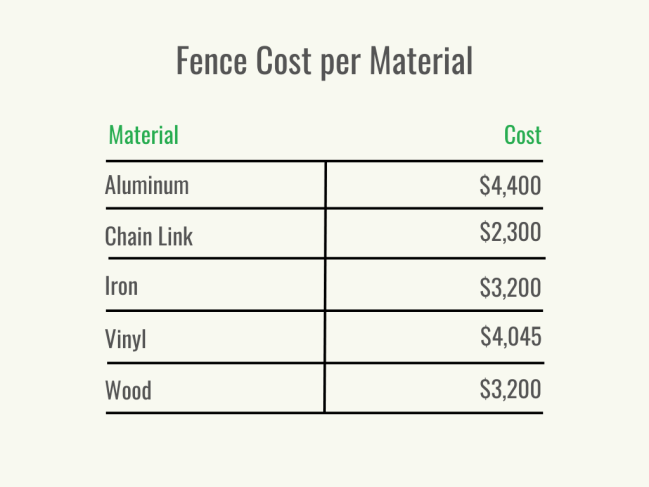
Other Fence Types
Vinyl fences are popular due to their durability, affordability, and appearance. However, there are quite a few fence materials that homeowners can choose from. Chain-link fences are one of the most affordable with an average cost of $2,300. Iron is an attractive option and typically costs about $3,200. Many homeowners find themselves comparing vinyl vs. wood fence costs because these materials have a similar look. While wood is less costly at $3,200, vinyl tends to have a longer lifespan. At the high end of the scale, aluminum fences cost close to $4,400 on average.
| Fence Type | Average Cost (Materials Only) |
| Aluminum | $4,400 |
| Chain link | $2,300 |
| Iron | $3,200 |
| Vinyl | $3,800 |
| Wood | $3,200 |
Types of Vinyl Fencing
Deciding on the type of vinyl fencing will be a big part of determining vinyl fence cost. Below are the main kinds of vinyl fencing homeowners can have a pro install.
| Type of Fencing | Cost per Linear Foot (Materials and Labor) |
| Lattice fence | $18 to $45 |
| Picket fence | $15 to $35 |
| Privacy fence | $15 to $40 |
| Shadowbox fence | $18 to $45 |
| Three-rail fence | $11 to $18 |
Lattice Fence
Decorative features can be built on top of a privacy fence to add another layer of cost-effective fencing. Lattice and crisscross patterns are two standard options. Otherwise, homeowners can consider installing a fence with lattice panels for a semi-see-through fence. And since it’s made of vinyl, this kind of fence will still last longer than a wooden lattice fence. Lattice fencing costs $18 to $45 per linear foot for materials and installation.
Picket Fence
A white picket fence is a quintessential property upgrade that can make a home look very appealing when it’s well kept. Since a picket fence is only a few feet tall, it’s much cheaper than a privacy fence. Some homeowners opt to add a privacy fence in the backyard and a picket fence in the front yard. It helps keep dogs and kids contained, but it still provides a view of the street (and boosts curb appeal). Homeowners can expect to pay $15 to $35 per linear foot to have a vinyl picket fence installed.
Privacy Fence
Privacy fences can reach as high as 12 feet tall, but most are usually 4 to 6 feet high. The higher the fence, the higher the cost. The advantage of a privacy fence is there are no slots for people to see into the yard—though it won’t be much help keeping nosy neighbors from looking into the yard from their second-story windows.
Still, privacy fences are the best option for those looking to enjoy their backyard without everyone walking by and looking inside. For homeowners with a pool, installing a vinyl fence can be a great way to add privacy for loungers while keeping pool fence costs low. And they’re especially helpful for keeping prying eyes from seeing any valuables that are stored in the backyard and keeping road noise down. Vinyl privacy fences cost an average of $15 to $40 per linear foot, including materials and installation.
Shadowbox Fence
Shadowbox fences have layers of panels that overlap one another so that light and air are filtered in while still blocking the yard from sight. The simplest shadowbox fences cost around $18 per linear foot, but costs can run up to $45, including installation and materials.
Three-Rail Fence
A three-rail fence, also known as a split-rail fence or ranch fencing, has flat rails between the posts (although they’re often round rails when made of wood), and they’re commonly used to keep animals penned in. A split-rail fence can be installed for less than the cost of a chain link fence, but they are much more aesthetically pleasing. Vinyl rail fences have been increasing in popularity for homeowners looking for a modern farmhouse style. Installing a split-rail fence costs from $11 to $18 per linear foot.
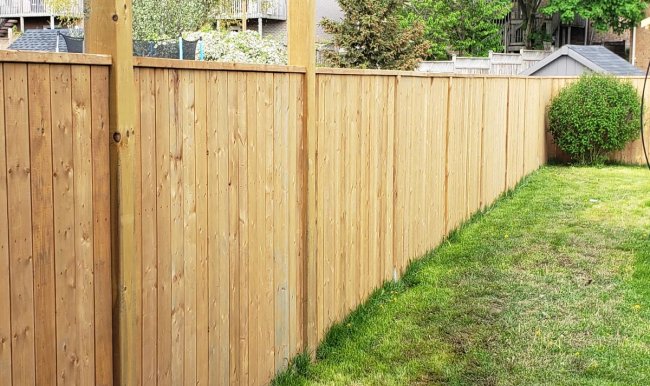
Benefits of Choosing a Vinyl Fence
Vinyl is one of the most popular materials for fence building. Plastic fences are far more durable now than their original counterparts, and they come with more options and colors. What follows are a few reasons homeowners might choose to build a vinyl fence.
Easy Maintenance
Straightforward, easy maintenance is the top reason to install a vinyl fence. When comparing wood vs. vinyl fences, homeowners will want to note that wood fences need to be stained or sealed yearly and will eventually rot, whereas vinyl fences are built to last. Best of all, they don’t require any sealing or staining—just an occasional power wash to keep them clean.
Strength and Durability
Vinyl fences are made of either pure vinyl or a PVC composite, both of which have long-lasting qualities and strength. For example, vinyl is five times stronger than wood. That means it just might last through a severe storm a little better than a wooden fence. They’re also more resistant to catching fire. Best of all, vinyl fences aren’t prone to rot, rust, insect infestations, sun blistering, or peeling. That’s why a vinyl fence can last from 10 to 30 years.
Long-Term Cost Savings
Vinyl fences are one of the best types of fences to invest in, since they have a long lifespan of 10 to 30 years. Although vinyl fences are more costly than wood fences initially, long-term costs are lower for vinyl fences, since they last longer and have almost no maintenance costs. It’s estimated that a quality vinyl fence averages a 60 percent return on investment (ROI) for homeowners.
Ease of Installation
Vinyl fences are one of the easiest types of fences to install—aside from the usual challenge of digging and installing fence posts. Vinyl fence panels are made to lock into place on the posts easily. While the average wrought-iron fence costs about the same as vinyl, wrought iron is heavy and carries the potential for injury and mistakes during installation. With vinyl fencing, as long as the posts are installed evenly, the panels will also be even when they’re snapped into the posts. If a panel is damaged, it’s just as easy to pull it out and snap in a new one.
Aesthetic Appeal
Vinyl fences have a clean aesthetic that boosts the property’s appearance, especially if it’s a traditional white picket fence. And since they don’t rot or warp like a wooden fence, they’ll maintain their crisp appearance longer. They’re a great way to boost curb appeal and have a long-lasting investment for years to come.
Pest Resistance
Even when wood is treated, pests will eventually wear down a wooden fence. Sometimes a wood fence’s demise becomes a race between the insects and Mother Nature. Thankfully, vinyl fences are created with artificial materials, so insects have no interest in nibbling away at them for food or nesting purposes.
Vinyl Fence Installation: DIY vs. Hiring a Professional
Many people have seen neighbors installing their own wooden fences. What might be overlooked are the frustrations those DIYers have as they try to get the posts lined up just right to install the rails and slats. Building a wooden fence is a challenge all on its own, but figuring out how to install a vinyl fence is a whole different beast. If even a slight measurement error is made when a homeowner is installing the posts, there are two choices: to try to cut the fence panel down and deal with an obviously cut panel, or to purchase a new panel that fits the space. That’s an expensive mistake to make.
Vinyl fences aren’t like wooden fences, since they come as fully prepped panels ready to pop into place. Homeowners who aren’t experienced at measuring the exact lines (both length and height), digging the post holes, pouring concrete, and setting the posts at the precise size and level are likely to wind up with a frustrating—and overly expensive—project. In reality, since materials are the most significant cost factor, DIYing will save only a few hundred dollars, and that margin could quickly be erased if new panels were to be needed due to errors. Homeowners will also want to keep in mind that while homeowners insurance may cover fencing that is damaged in a storm or other event, a claim could be denied if the fencing was installed incorrectly to begin with.
Professional vinyl fence installers use a great deal of precision as they work to install a vinyl fence. Their skill and efficiency are a huge advantage for homeowners, who will be able to spend their time on other projects or with their family. The best fence companies will also have all the right equipment like post diggers, which is not a common tool most homeowners have. In reality, hiring a pro for a vinyl fence installation is the best way for homeowners to avoid costly mistakes and big headaches.
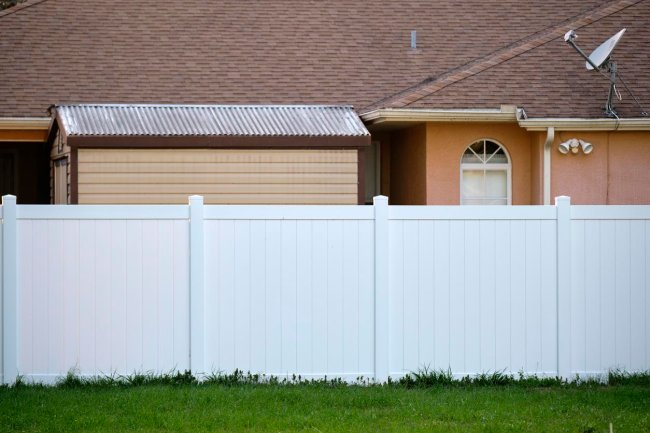
How to Save Money on Vinyl Fence Cost
It’s common to look for ways to save money on a vinyl fence installation. Remember that vinyl fences are a savings in themselves, since they need little maintenance and last much longer than wooden fences. What follows are several tips for homeowners looking to save on vinyl fence costs.
- Explore panel options. Ask the installer about the total price difference for installing a fence with 4-, 6-, or 8-foot panels. Smaller panels will require more posts, so even though larger panels cost more, they might be cheaper overall.
- Go shorter. Build a 6-foot privacy fence instead of an 8- or 10-foot fence.
- Consider a lattice top. Ask about the cost difference between building a taller fence and adding decorative lattice on the top. Some homeowners plant vines and create an additional privacy barrier that’s attractive and costs less.
- Clean up the yard yourself. Remove any landscaping on your own if possible to avoid labor and dump fees.
- Remove your own old fencing. Either haul it yourself, or ask about the cost for the installer to haul it away.
- Keep it simple. Skip the decorative handles and extra features, and opt for the hardware that will last best in your climate.
- Wait for the offseason. If possible, have a fence installed off-season when demand is lower. This is often in the middle of summer, since most homeowners want to get a fence built right after or before winter.
- Start with the back. Skip building a fence in the front yard and only build one for the backyard for now. You can always build the front yard fence later.
- Install only one gate. If you can get away with a single gate rather than a double gate, this can reduce costs significantly.
- Shop around. Always compare quotes from multiple companies, especially if you have a special consideration like a sloped property.
- Choose the style carefully. Consider a cheaper type of fence such as a rail fence if your goal is more about enclosure than privacy.
- Share the cost. Ask your neighbors to chip in for the portion of the fence that will separate their yard from yours.
Questions to Ask About Vinyl Fence Installation
Since a few special circumstances can apply to the project, it’s important for a homeowner to know what questions to ask a fence installer about the costs of vinyl fencing and the project itself. As always, homeowners will want to be sure to ask if the company’s employees are licensed, bonded, and insured first.
- Do you have a portfolio I can review and references I can call?
- Do you obtain the permits I need?
- Will you come to my house and do a free estimate?
- Can I review a line-item estimate or invoice?
- Do you require a deposit?
- How will you identify my property lines?
- Will you contact the utility companies to ensure you don’t dig up any gas or internet lines?
- What’s the cost difference if I choose a smaller or bigger fence panel?
- How much do you charge for one gate?
- How many fence posts will my property need?
- Can you remove my old fence?
- Do you see any installation challenges on my property?
- Will the slope in my yard require grading?
- How long will it take to install my fence?
- How many employees will you send to build the fence?
- Do you offer any warranty on the fence?
FAQs
After deciding on the kind of vinyl fence to install and the length of the fence, a general idea of the vinyl fence costs will emerge. But having more information is always helpful; below are the answers to some commonly asked questions.
Q. Is vinyl fencing cheaper than wood?
Not necessarily. It partly depends on the type of wood, since some varieties are more expensive than others, but wood fences cost less than vinyl in general. Still, there might be a close price difference depending on current wood costs.
Q. Is vinyl the same thing as PVC?
Mostly, yes. PVC is short for polyvinyl chloride, so technically, all PVC has vinyl in it. PVC is typically made of a variety of composite materials, including vinyl, and it’s a little cheaper and a little more flexible than pure vinyl. There is another type of fencing called virgin vinyl that is 100 percent vinyl, and it’s known to have even stronger resistance against warping in extreme heat. It resists fading colors and will break cleanly rather than leaving shards of fibers if it’s damaged.
Q. How long can a vinyl fence last?
Most vinyl fences last anywhere from 10 to 30 years, depending on the weather conditions and the type of materials used to make the vinyl fence.
Q. How much does a 100-foot vinyl fence cost?
For a basic plastic vinyl fence that’s 100 linear feet, costs may be between $1,500 and $6,000, depending on the fence design, labor, terrain, and number of gates.
Q. Is a vinyl fence good for dog owners?
Vinyl fences are a top choice for dog owners. Dogs tend to want to scratch, sniff, and otherwise agitate a wooden fence. Wood also tends to have insects, and it carries the scent of other animals longer than plastic. Vinyl fences are uninteresting to dogs who won’t feel a need to scratch or sniff it all the time.
They’re also safer for dogs than chain-link fences or iron fences, which the dog could potentially get stuck in. And since plastic fence panels are installed in a single piece, there are also no rusty or broken nails to hurt furry friends.
Q. Do I need to paint vinyl fencing?
The short answer is no. Vinyl fencing does not need to be painted, since it comes in white, red, beige, black, and brown. Those are the most common colors that are also widely accepted to an HOA (if that’s a consideration). Vinyl fences do not require yearly painting, staining, or sealing as a wooden fence does.
That being said, it is possible to have a vinyl fence painted a different color. A professional will likely use epoxy paint, but the caveat is that the paint will not last all that long. Since paint doesn’t adhere to smooth plastic as well as porous wood, it will eventually peel off and look unsightly—thus undoing the crisp appearance of a nonpainted vinyl fence. Most importantly, painting a fence could void the warranty, so ask the fence installer before painting it.
